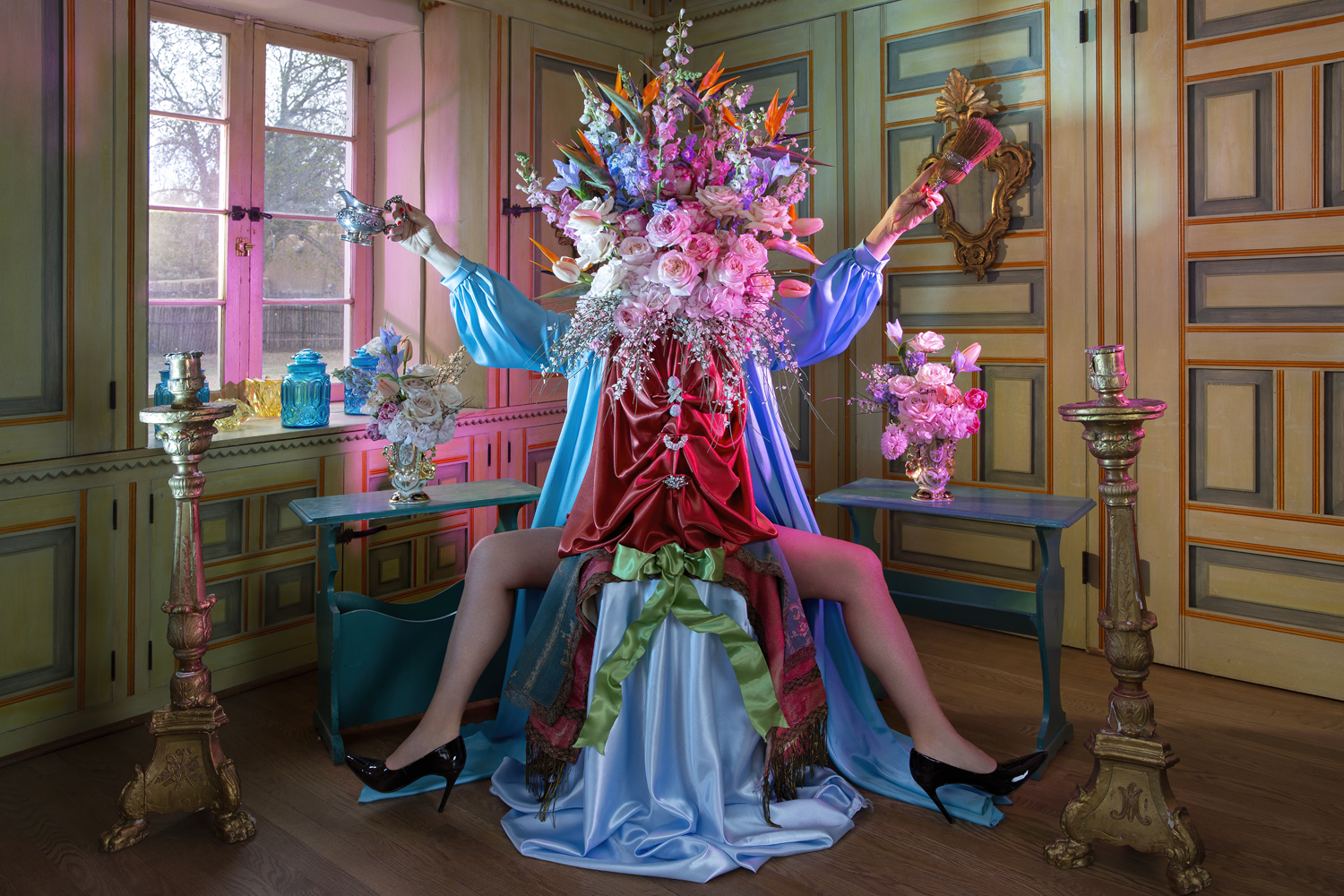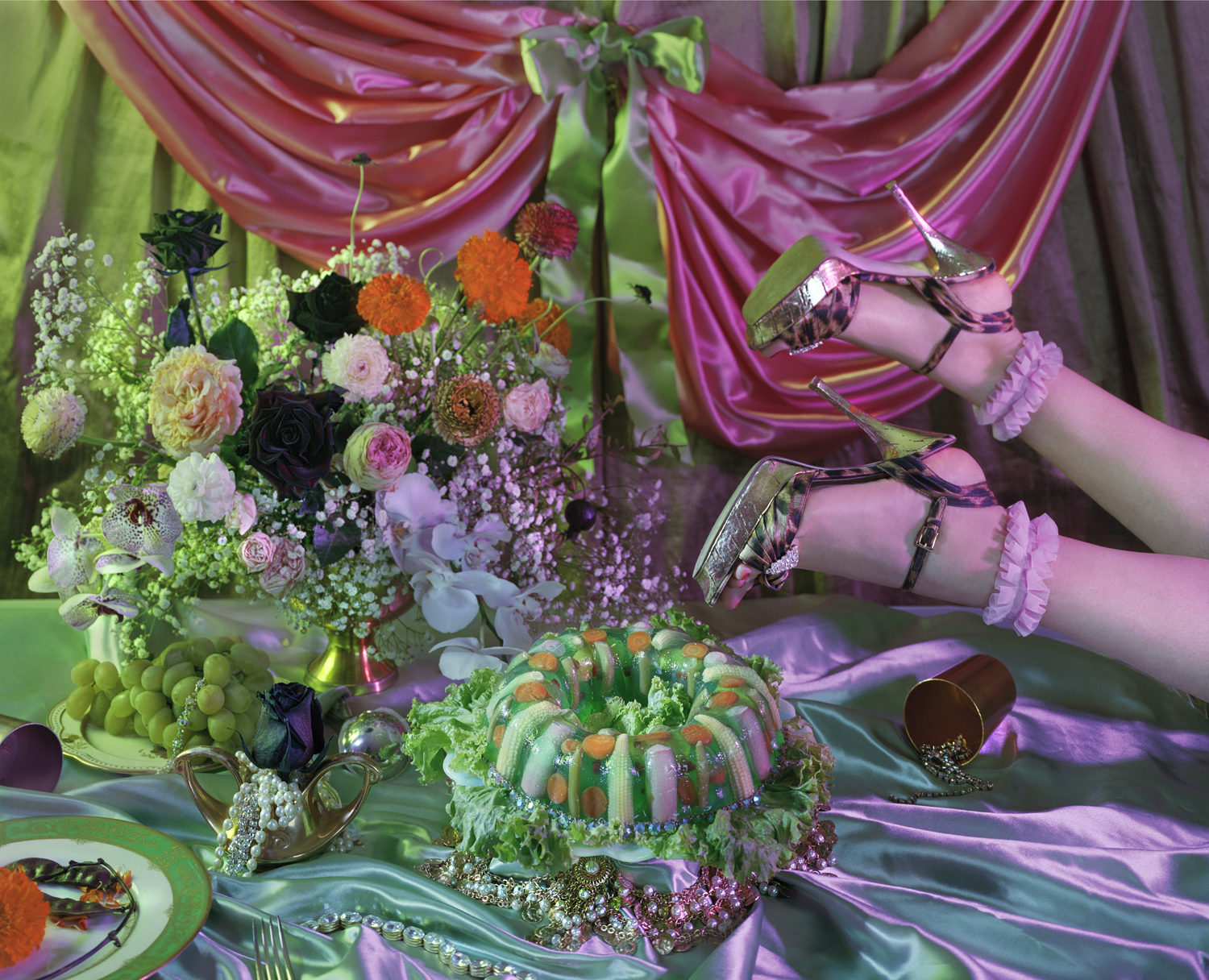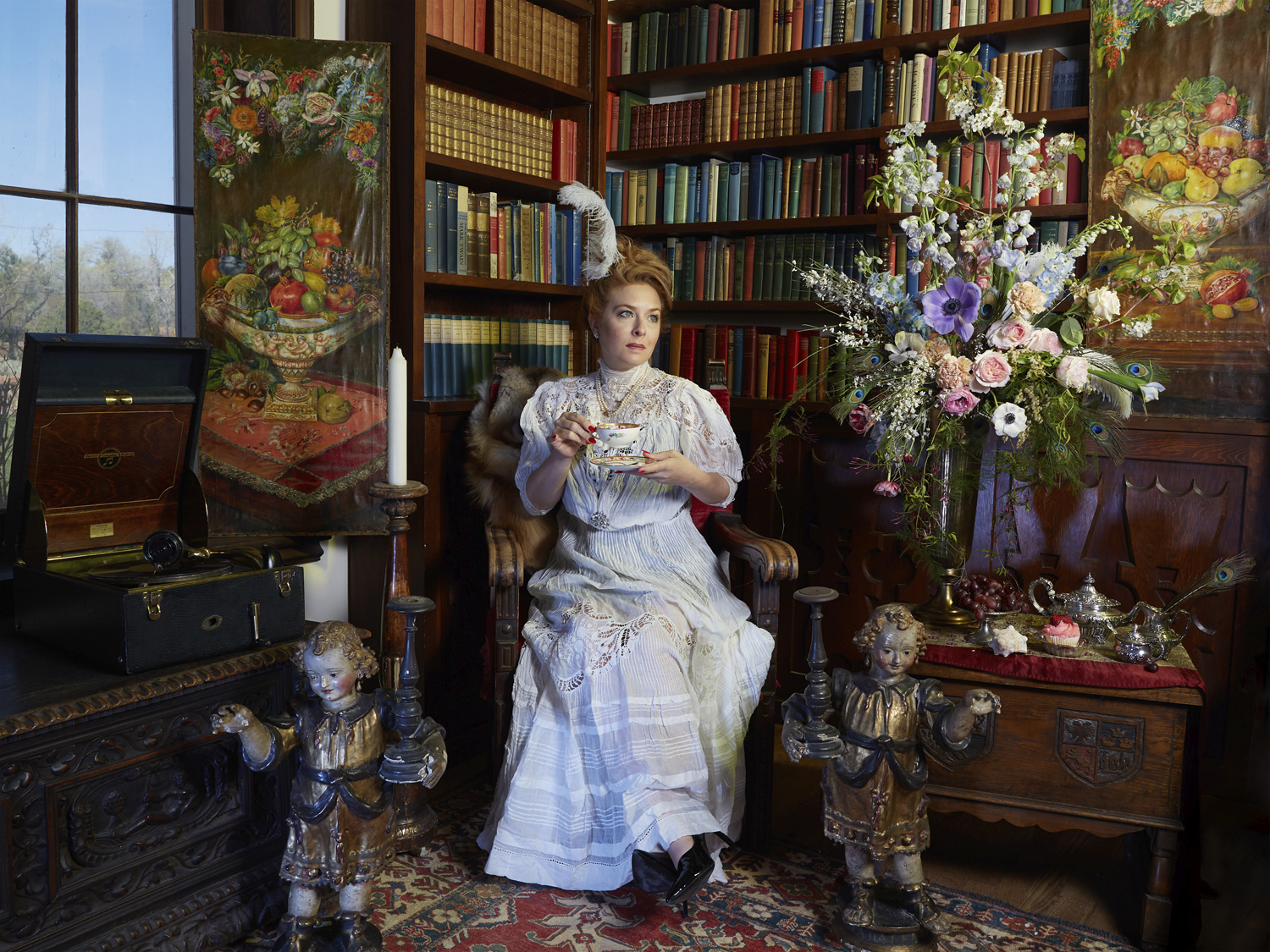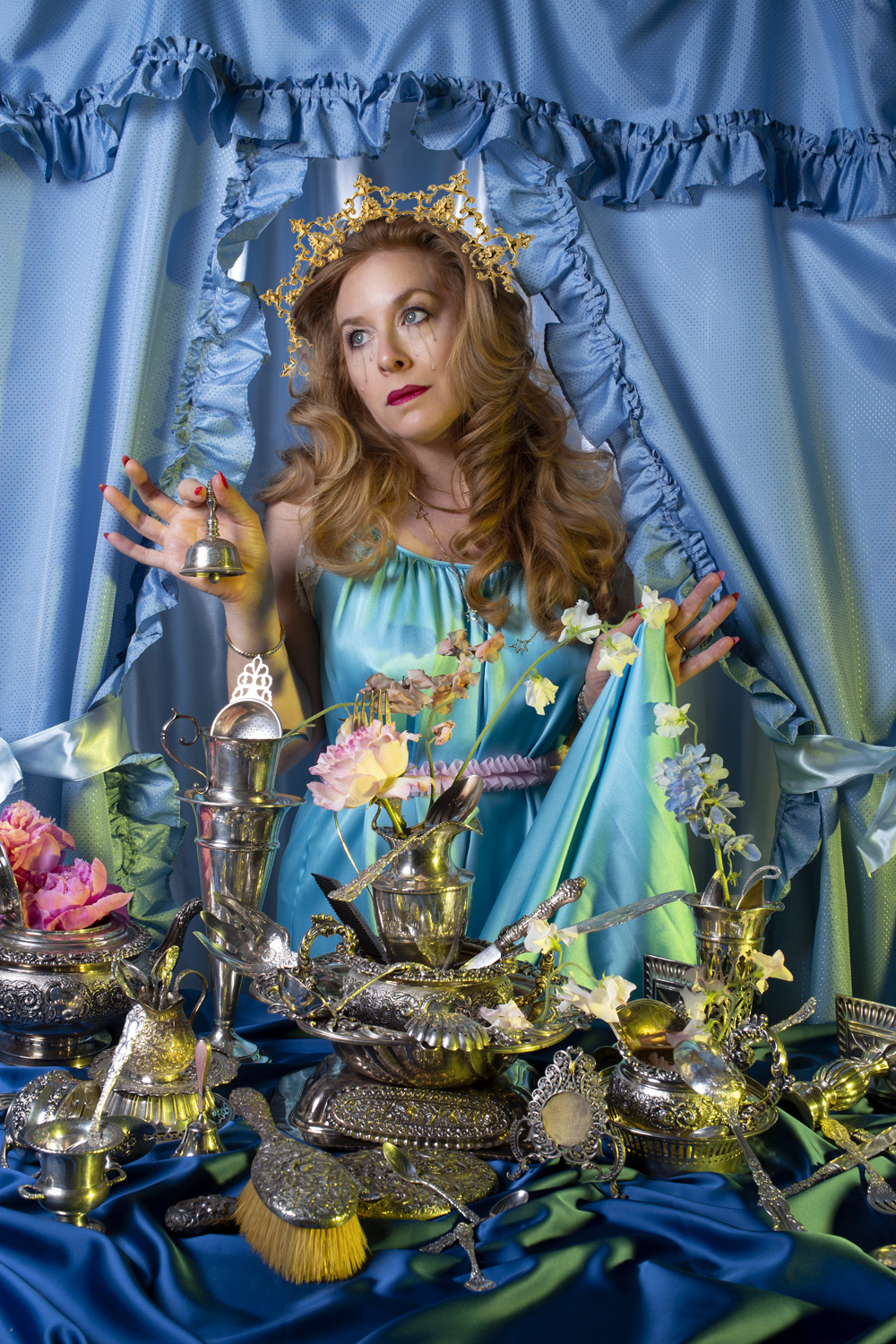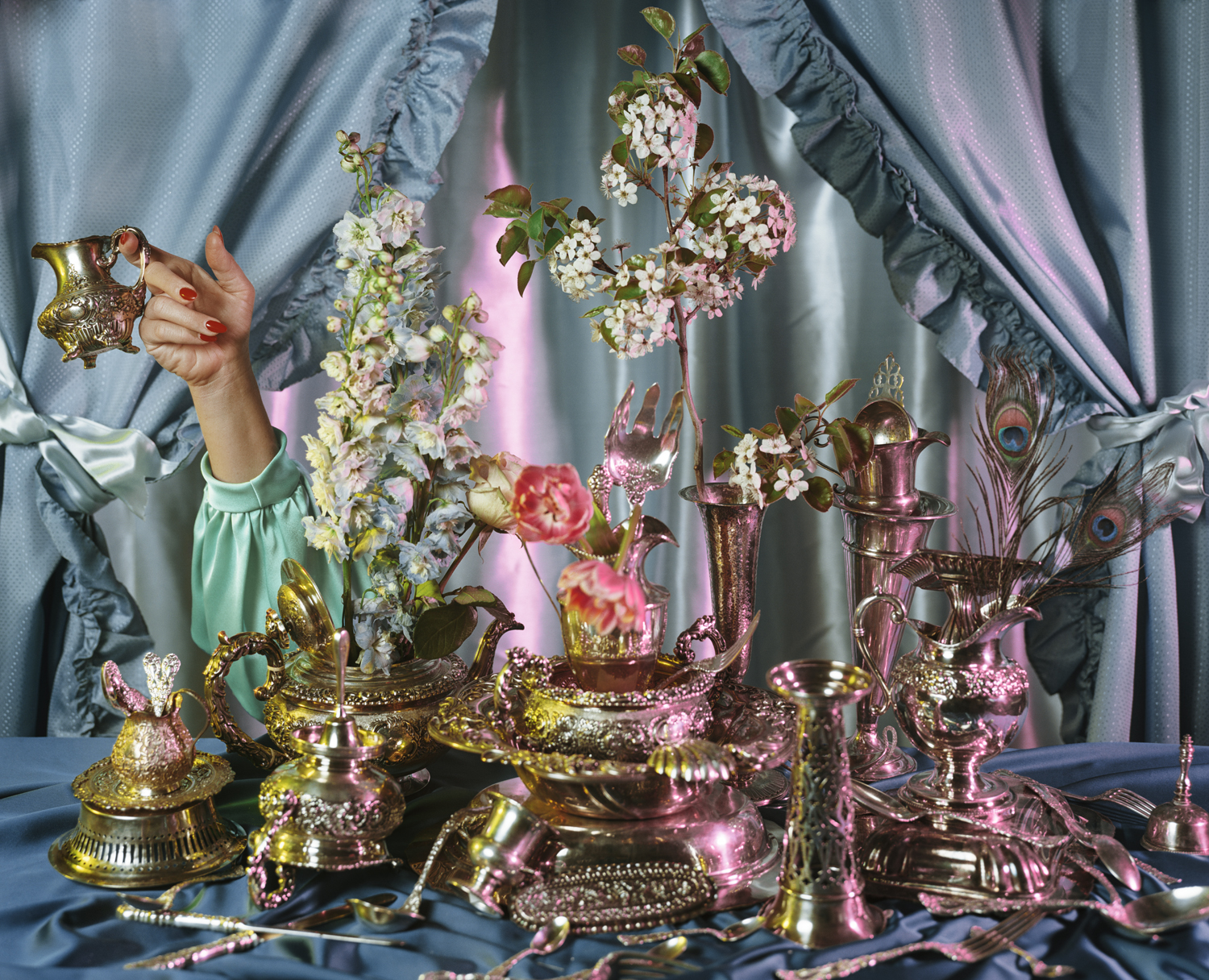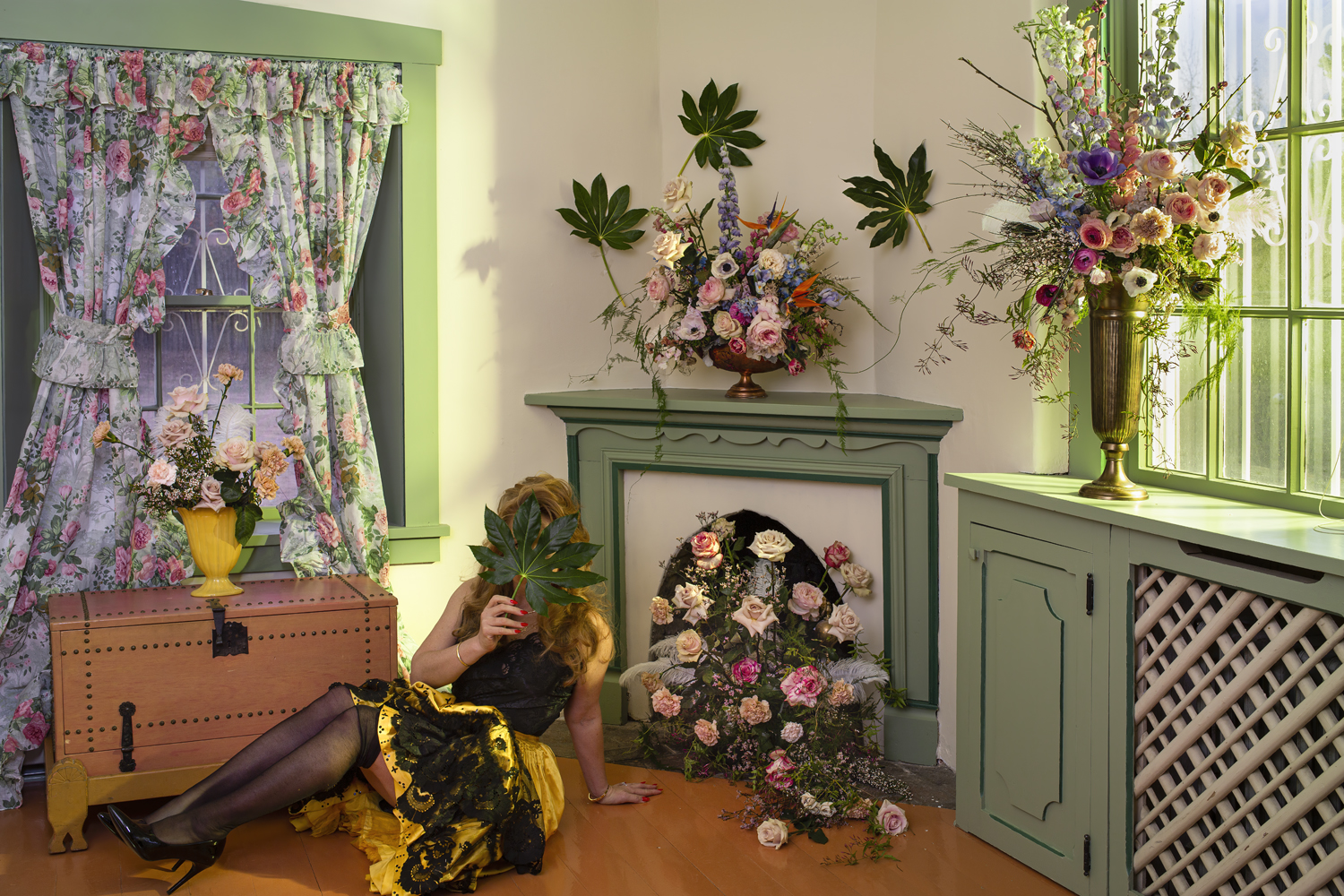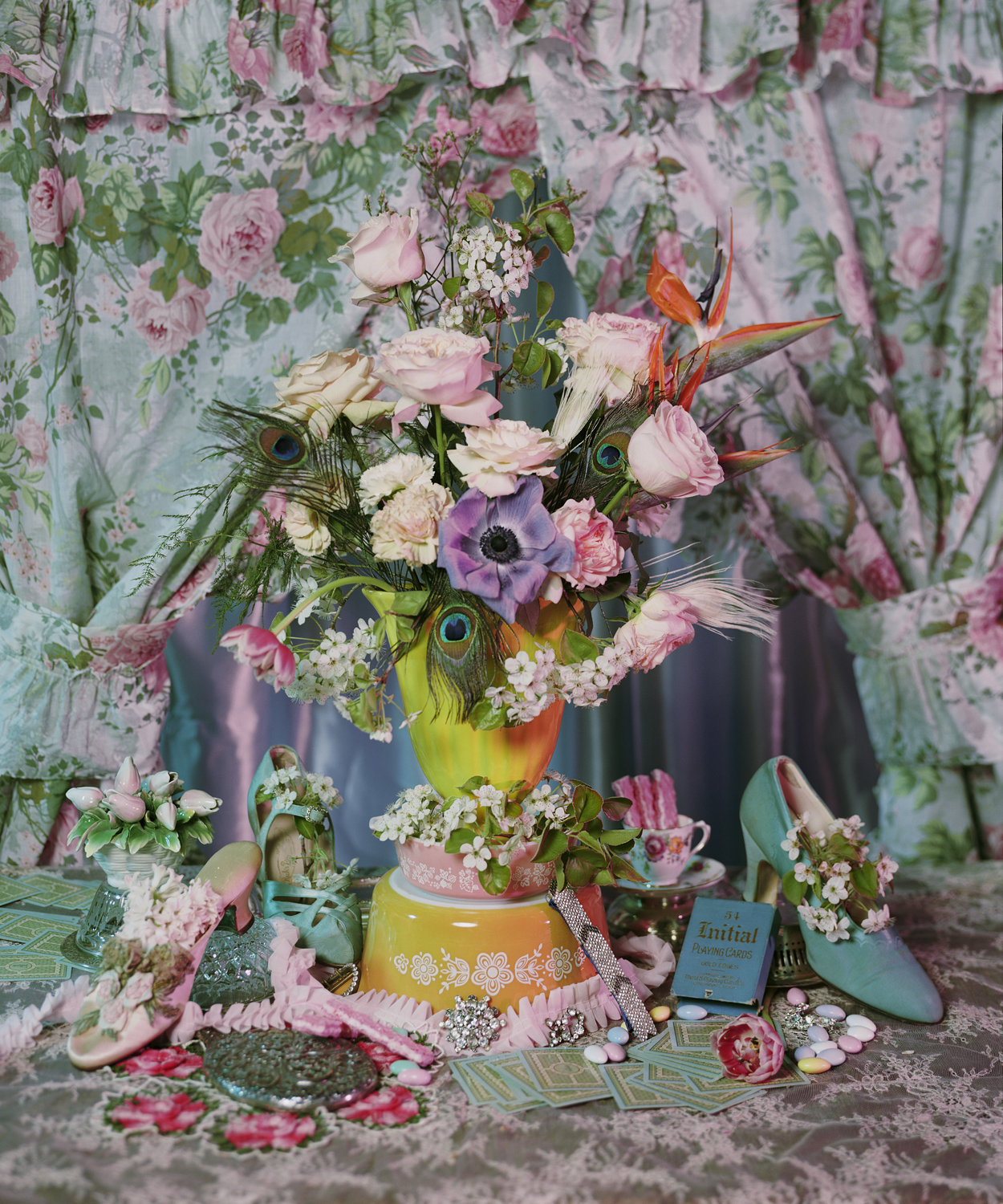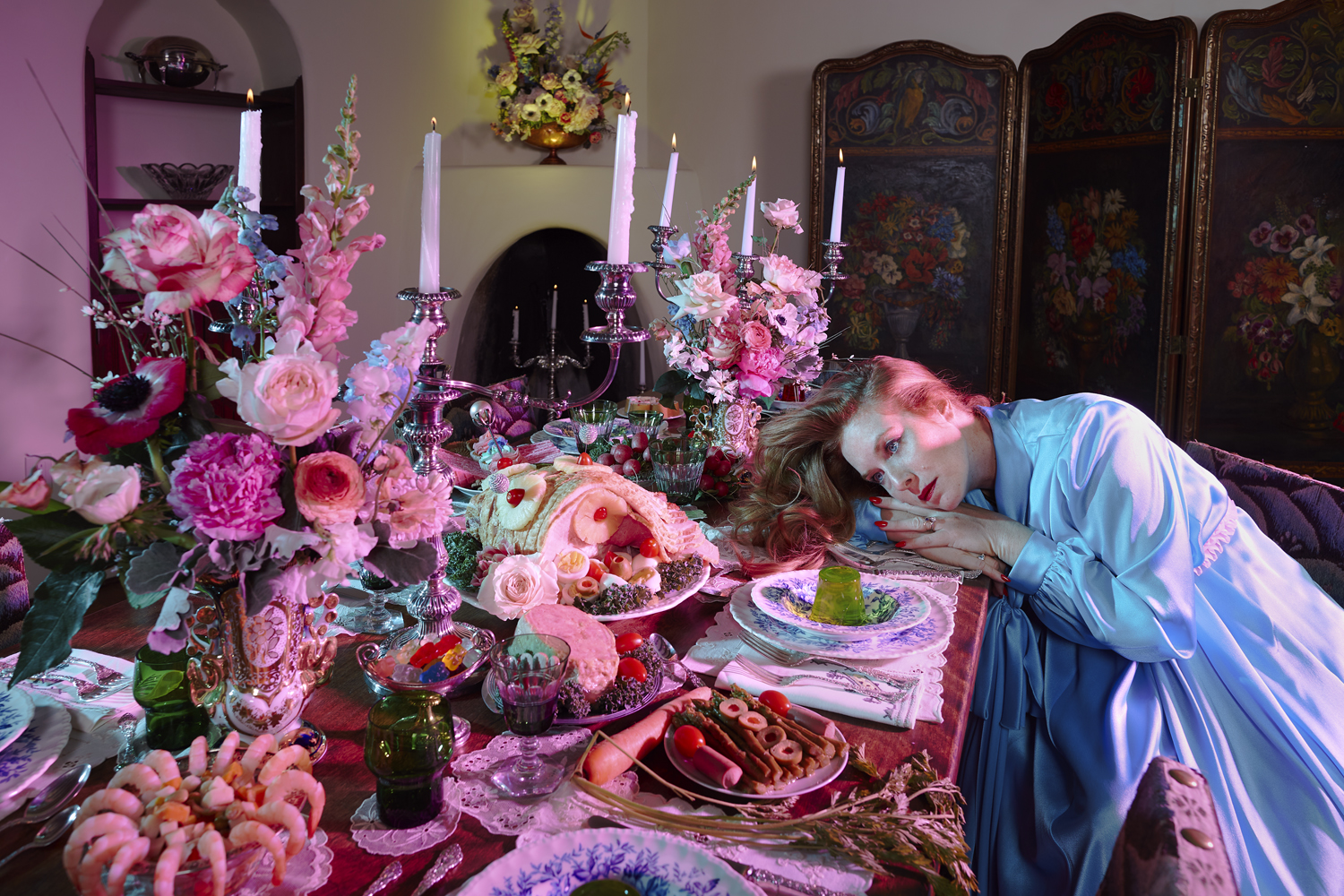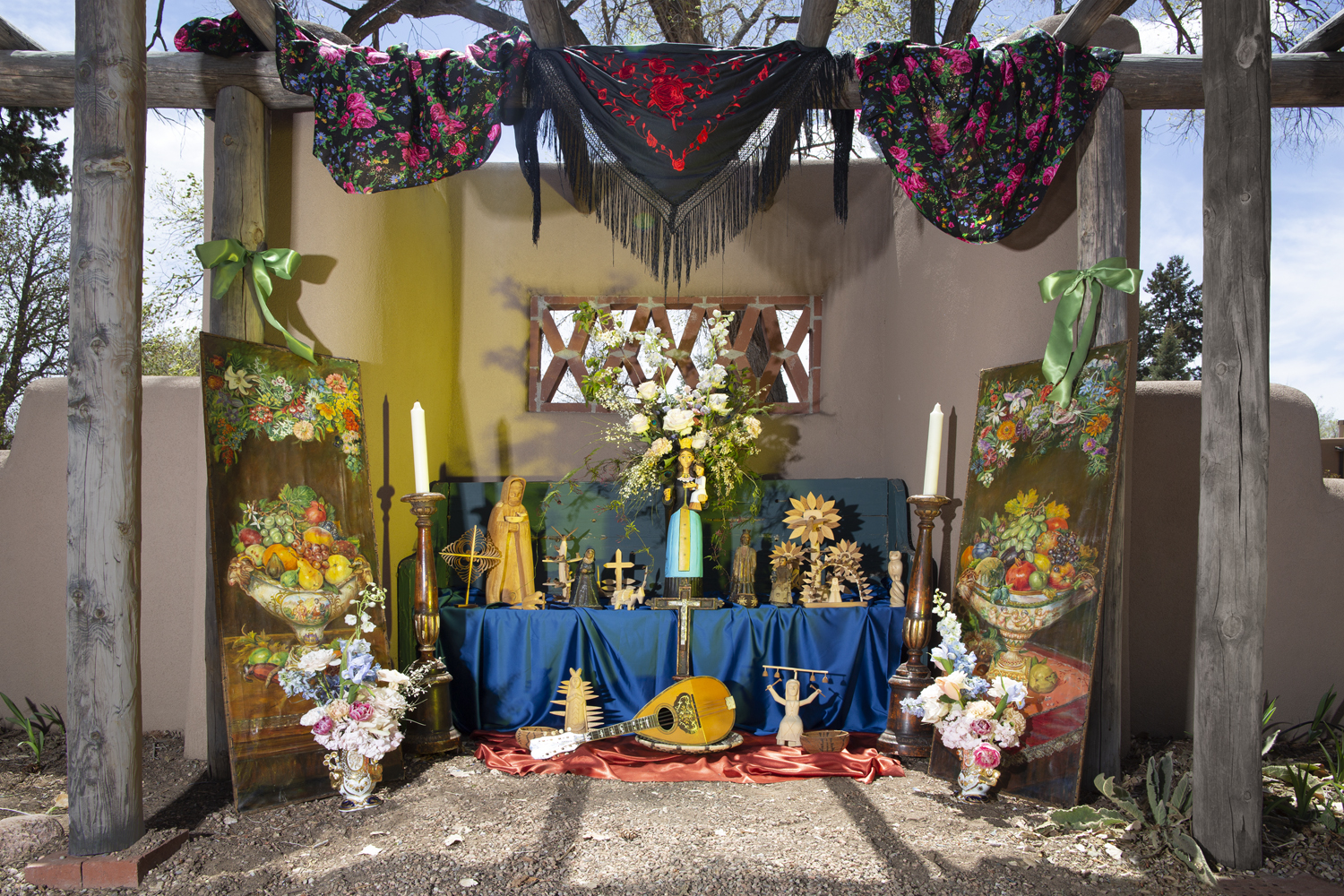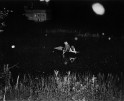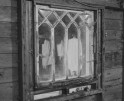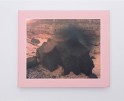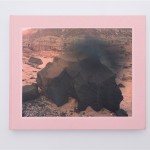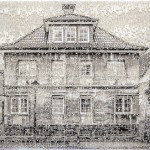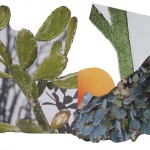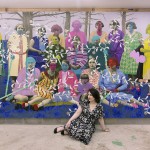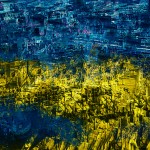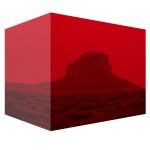Amanda Rowan: Place Setting
Objects are what matter. Only they carry the evidence that throughout the centuries something really happened among human beings.
– Claude Levi-Strauss
By immersing herself in the objects and collections of women, Amanda Rowan illuminates the ideas of history and matriarchal duties. In the series Place Setting, Rowan uses intricate compositions and bold lighting to transport herself into the minds of the descendants of the Acequia Madre House. Creating this work in their home, Rowan reimagines the space in a way that honors the struggles these women faced. Place Setting is a series that challenges the ideas of class, gender, and what it means to be the matriarch.
An exhibition of Rowan’s work, Place Setting runs from May 20 – June 30, 2022 and introduces the evolution of the Acequia Madre House from a historic house museum to a space for contemporary art that engages with history.
Amanda Rowan’s provocative still life and self-portrait images depict playful and sensual moments, eliciting humor through an exploration of the power and vulnerability of womanhood. Rowan is both curator and subject in each richly styled vignette depicting moments of mysticism and seduction. Her work explores domestic labor and gender using a mix of visual iconography, including food advertising, vintage pinup, and religious deities.
Rowan has received numerous accolades for her art, including “The Curator Award 2019″, by Photo District News (P.D.N.), “Photographer of the Year 2018″ by the International Chromatic Photography Publication, and the Tokyo International Award for Photography in 2019. Her work has been exhibited internationally at the Carrie Able Gallery, Photo LA, Art Basel, The Wall Street Gallery, and The Leica Gallery in Los Angeles. Her images hang in the permanent collection at The Palms Hotel in Las Vegas with Damien Hirst, Jean-Michel Basquiat, Andy Warhol, and Takashi Murakami.
Originally from the Bay area, the daughter of Bluegrass Legend Peter Rowan, she began shooting rock concerts during high school. Her distinctive visual style has translated into advertising campaigns for clients, including Disney, NBC, and HBO. Her editorial portraits include global artists, performers, and pop celebrities alike.
Rowan graduated Cum Laude from Tisch School of the Arts at NYU. She resided in New York City for several years appearing as an actress in film and TV such as “Law and Order”, the “Chappelle Show” with Dave Chappelle, and National Lampoon’s “Pledge This!” co-starring with Paris Hilton. She performed several roles on Broadway including Curles’s wife in “Of Mice and Men.” Her creative practice combines an investigation of her experience as an actress and her Visual Prowess as a commercial photographer. Her work investigates ideas of the female body in the media and its intersection with contemporary visual content creation. Rowan now lives in Los Angeles, working within the genres of photography and performance art. Rowan is currently a Full-Time Faculty at the Photo Arts Conservatory at the New York Film Academy Los Angeles in both the MFA and BFA programs.
Place Setting
In a year when much of the world was confined to their homes or under imposed travel restrictions due to coronavirus, I too was immersed in a domestic environment – but not my own.
Created during a Fellowship at the Women’s International Study Center at Acequia Madre House in Santa Fe, New Mexico in April 2021 – my latest project ‘Place Setting’, is a multimedia performance piece of photography, film, and sculpture.
I immersed myself in the House and in the lives of the women who inhabited it. The matriarch, Eva Fényes, moved to New Mexico in the late 1800s during the Gilded Age. At the time, it was one of the few American territories where divorce was legal, and a single woman could own land. Through her efforts, the space has fostered local artists and craftspeople for over 100 years.
I examined, interpreted, and took inspiration from the extensive archive of personal artifacts of Eva, her daughter, and granddaughter – who left behind an extraordinary record of their times in letters, journals, publications, albums, photographs, art, and artifacts. The work includes recreated elaborate dinner parties from archival recipe books – which explore the surrealist narrative of domestic labor as well as themes of property and independence linked to the trappings of class and gender.
I sought to capture the duality of the space. In one sense, a reaction to privilege and aristocracy, and at the same time, a celebration of autonomy in the American Southwest as independent women. -Amanda Rowan
I would like to start off by discussing what influences your work. Are there any artists or photographers that inspire you?
Yes, I’m definitely inspired by other people. That is a huge thing, especially nowadays when I feel the daily practice so involves the curated feed of artists I love through my dependence on Instagram. It feels like a steady stream of influence, and I’ve noticed there’s a collective making that’s happening within the world of female photographers. Even within the genre of still life and self-portraiture. I know that many of us follow each other, and I see a lot of things being rift on within each other’s work. An elemental quality is this sense of the camp retro iconic tropes of women. I think there’s a consciousness that I’m keyed into, particularly with contemporary makers.
A few people I admire and draw inspiration from are Jo Ann Callis, Judy Chicago, Věra Chytilová, Agnès Varda, Pipilotti Rist, Uldus Bakhtiozina, Allison Morris, Mous Lamrabat, Samantha Margherita, Nadia Lee Cohen, and Brooke DiDonato. My students and fellow faculty at the Photo Arts Conservatory at NYFA are a huge inspiration!
You have accomplished quite a lot in the past several years. In addition to being an actress in many films you also began your photography career by shooting rock concerts. How have these experiences informed your photography?
Well, being an actress and a performer informed my practice as a whole, in that it always gave me permission to be a subject. So, whereas just coming from straight capital “P” photography it’s like we are the person behind the lens and everything on the other side of the lens is the subject. Being in film and theatre and becoming the performer on the other side of the lens is something I feel really comfortable with. I feel comfortable flipping to both sides.
My father is a musician and my godmother’s a singer. I grew up around a lot of very talented grownups who were performers and musicians and when I started using a camera at a young age it became a way to respectfully engage with them. I was making work that documented them and that became a way that I documented other musicians around my age. It became this skill I had. That was my way of being a photographer. I learned this skill to engage with other artists and it became a tool and a way to make money. I did that for many years, documenting other artists, which I still love to do, however, there was a major pivot in my career about six years ago. I kind of moved away from that world for a period to reconnect and find my own voice.
You have a very unique style of photography using bright colors and complex compositions. How did you develop your style?
My mother and her mother are both big collectors of objects, so I feel this tradition of collecting and curating, especially in the home, is something that I grew up noticing and valuing. That could be a collection of baskets she’d pull out and arrange around Easter, like tableaus. As a child, I would take my dolls and my mother’s objects to set up these little worlds all over the house. My mother likes to remind me that I was always very adamant about not taking down my setups, as if they were in the middle of something. They’re important, they’re doing something. It’s always been an expression of mine to arrange and create these little worlds and tableaus.
I love that you’ve grown up with this and made these childhood memories part of your photography. That is really special.
I think so. Something I’ve noticed as I’ve gotten older and gone through many incarnations of expression from acting to photography, to playing music, is that all these forms are part of the same cohesive expression. I feel really lucky that I’ve come to a place where I start to notice and accept that.
In your statement you say you drew inspiration for this project by immersing yourself in the Acequia Madre House and with Eva Fényes and her descendants’ belongings. Could you describe how you began the process of conceptualizing and composing these scenes?
It’s such a cool story. There is a photographer named Lisa Law who is located in Santa Fe, New Mexico, and her daughter is Pilar Law who’s also a photographer who I met when I was younger. Pilar and I fell out of touch, she opened a gallery then became a curator, and decades later we met again through the photo community. Pilar became familiar with my photographic work and had started working at this museum, the Acequia Madre House. The museum was going through a shift since a new director, Jordan Young, took it over. Young wanted this space to become a museum for women and artists making work today and wanted to create more of a conceptual art space. Through Pilar, the museum reached out to me with the task of somehow making a new contemporary body of work that engaged with the history of the space, the objects, and aspects of these women who built the museum over three generations. That is how this project started and we had discussions back and forth to see if I could actually come to the museum when it was safe to do so. This was happening during COVID so I had a lot of time to be thinking about this project. By the time I finally went there I knew that I wanted to make these tableaus in the architectural space of the museum.
I researched a lot about the history of the space and about the women who were collectors during three really interesting time periods. The matriarch, Eva moved there and built this house towards the end of the gilded age, so it’s very opulent, with tea sets, formal wear, and very fine lace. Eva came from New York City in the late 1800s and she brought this sort of high-class world to New Mexico. New Mexico at the time was seen as this frontier of freedom with cowboys, Native American culture, shamans, and spirituality. She then raised her daughter and granddaughter there. The daughter collected during the 20s and 30s and then her granddaughter collected more during the 50s and 60s. Because of this, there were all these objects that I got to work with from these different time periods that were subtly infused with the space of Santa Fe, which is almost in juxtaposition with the frilliness of all the women’s objects. I think of Santa Fe as having this South Western aesthetic yet these women were had been featured in Vogue magazine. They were pillars of fashion and society which doesn’t match the landscape. It was interesting put it all together and think about these ideas.
How much time did it take you to compose each scene? They are all so elaborate and seem as if they would take a lot of planning.
I basically created the work in about ten days, and we filmed it in about two weeks. We filmed it like a movie, with a director of photography and I had a few assistants. I had two incredible florists collaborating with me, Marisa Bosquez-White and Melissa Paquin. The dinner party took a lot of time. We had to do prop scouting and gather all the food and make the food, which took several days. My practice for that project was closest to a movie set because the lighting was really cinematic and the vast number of people I had to help me, physically, because I was also the subject. It was a big production for sure. We shot videos during the whole thing to create little narrative moments. I was really interested in this because this was the first time I had created a body of work in a place not in the studio or on a mountainside. Being in this home really felt like we were on the set of a film, so I was interested in these moving gestures. For the exhibition that will be opening in May, there is a film that we have of just the tablescape and the banquet.
Many of these compositions feature several items and many iconograph items. How did you know when to stop adding objects? Was there a point where you felt they were complete?
When sourcing the objects, I had this incredible access to them. The museum was basically excavating the sites and was in the process of archiving and organizing. When I got there everything was out, and I got to go in, with white gloves and carefully choose everything I wanted to possibly use. I laid all the items out on a long vanquish-like table in the middle of the great room and every day, I would go to the table and consider what to use. I considered what hadn’t been photographed yet, and what would work well together. I had these rough theme ideas to guide me. Realistically I would just keep adding until it looked good. I don’t know if I stopped in time but I stopped when it felt luscious and painterly.
You talked earlier about using this cinematic lighting. Could you share more about your reasons for using this bold lighting and creating these harsh shadows?
Well, I designed all the lighting and I did choose to make it very shadowy. I liked the look of designed and really curated lighting. To me, it feels like if you’re going to use lights why not really use them. The shadows, the color gels, and the elements of the lighting just add so much fun to the image. They’re like paints. I love the way that the lights, the colors, and the shadows change the object. I make these sculptures and if you just look at them in natural light they’re very pretty, however, the only way to really see the sculpture is when you use strobes. That moment when the strobes fire and create that cool lighting is when you truly see the piece. I think shooting music venues, concerts, and being in theater influenced me, with all that colorful, dramatic lighting. I’m always curious about how I can do something really cinematic and add it to something conceptual.
Food is heavily featured in your work, and I can’t help but notice how some of the scenes feature delectable-looking meals while others feature pairings that seem somewhat odd. Why did you photograph the food in this way?
I am a complete foodie. I love food and I really do like to cook all the time. I think it’s so beautiful to be a home cook because you make this art piece and then you feed people and it’s gone. I think that it’s super meditative and causes you to be present because you’re making this very special thing that is immediately consumed and finished. I love that element of food as a thing.
I am drawn to the aesthetic of early cookbooks and early American and French cuisine photography. To me, it is so horrific and unappetizing, yet the disassociation of those people being so proud of what they were making is humorous. I feel like humor is inherent in food that is slightly off.
I was looking at cookbooks that these women had collected. They also kept an immaculate record of dinner parties they hosted, menus they were planning, guest lists, etc. They also had so many objects, flatwares, and things attached to specific dishes for use in specific dinner party settings. I just wanted to recreate that in a playful way. I was there, creating this during COVID and there was also this real sense of making this big dinner party for no one. It became this expression of this feeling of still wanting to be creative but having no point because it was just me. It was this explosion of beauty and horror in a dinner party that would only be enjoyed by me.
I notice that there are only a few images where you choose to show a face or body part. Would you elaborate on why you chose to do this?
Well, in the project I had done prior called Ritual, I do not appear in it with my face. To me, that was really important as someone who had spent my career being an actress and photographing other people’s portraits. I was so curious and excited to make work that had no face. Through intentionally obscuring my face, I realized there’s a huge amount of power in an image that doesn’t show a face because it lets the viewer project. When a face is shown a lot of the narrative and story is handed to you. For this project, I was a character in it, but I felt the character I was playing was these women. There is a certain shot where I’m in the library I’m wearing this late 1800s dress and I really just wanted to become her. My husband said that I didn’t even look like me, so I think I was embracing the spirit of these women. Even when I am showing my face in these photos, it doesn’t feel like me. It is as if I am letting these women come through.
Is there anything you want to divulge about your upcoming exhibition?
The exhibition is going to be in the exact same museum, the Acequia Madre House. They are reopening for the first time after COVID with this show. It will open on May 20th and run through the end of June. It will have a lot of experiential elements for people to create their own portraits and their own art.
Posts on Lenscratch may not be reproduced without the permission of the Lenscratch staff and the photographer.
Recommended
-
ALEXIS MARTINO: The Collapsing Panorama April 4th, 2024
-
Rebecca Sexton Larson: The Reluctant CaregiverFebruary 26th, 2024
-
Interview with Peah Guilmoth: The Search for Beauty and EscapeFebruary 23rd, 2024
-
Brice Bischoff: How CloseFebruary 18th, 2024


